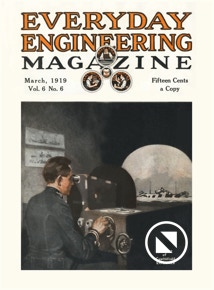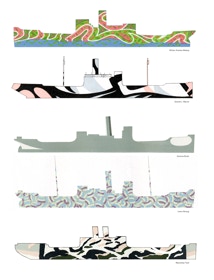Above Howard V. Brown, cover of Everyday Engineering, March 1919. A camoufleur is shown testing a dazzle-painted ship model.
Unsigned, “A Camouflage Bureau” in The Bridgeport Telegram (Bridgeport CT), May 4, 1918, p. 16—
Few of us were aware that the Navy department has such a thing as “a camouflage bureau.” Yet there is such a bureau. Recently a British officer slipped over here without heralding and taught the bureau a few tricks.
Commander Norman Wilkinson is the man. He introduced what is called “the dazzle system” of painting vessels. It has been highly successful and our government employs it.
One thing is certain, Commander Wilkinson knows how to dodge even the newspaper fellows. He came into the land and was about to return home before they found it out. Incidentally he made his trip to this country part of his honeymoon journey, getting married just before coming over…
Above Interim camouflage schemes approved by the US Navy in 1917.
•••
EVENTS
Based on research by
Roy R. Behrens, as published in FALSE COLORS: Art, Design and Modern Camouflage (2002); CAMOUPEDIA: A Compendium of Research of Art, Architecture and Camouflage (2009); and SHIP SHAPE: A Dazzle Camouflage Sourcebook (2012)
CAMOUPEDIA
A chronology of the development of
Allied ship camouflage during World War I
1899 During the Spanish-American War, US artists Abbott H. Thayer and George de Forest Brush proposed that ships should be protectively colored by a method found in nature called countershading. But the war lasted only briefly, and the issue was no longer urgent.
1902 Thayer and Brush’s teenage son, Gerome Brush, obtained US Patent No. 715013A for reducing the visibility of a ship through countershading.
1909 After years of work, Thayer and his son, Gerald H. Thayer, published a major, pioneering book on protective coloration in nature, called Concealing Coloration in the Animal Kingdom. While widely read and often praised, some of its claims were dismissed as absurd.
1914 Soon after World War I began, artists in the French Army demonstrated the value of disruption and blending in ground camouflage, in answer to developments in long-range artillery, observation from the air, and aerial photography. Newly referred to as camouflage, it was promptly adopted by others as well.
1914 In September, Scottish scientist John Graham Kerr, who had conducted pre-war experiments in ship camouflage, called for the use of disruptive patterns, called parti-coloring. His ideas were tested, then largely ignored.
1915 An American muralist named William Andrew Mackay, working with US Navy officers Joseph O. Fisher and Kenneth Whiting, used diamonds, stripes and checkerboards in designing disruptive camouflage plans for American submarines, called K-boats.
1917 From January to mid-April, German submarines successfully torpedoed 500 British ships. In the rest of that month, an average of 13 ships were sunk each day. Skeptical of the effectiveness of “low visibility” camouflage schemes, British artist Norman Wilkinson proposed to the British Admiralty that ships be painted “with large patches of strong color,” to distort their appearance to such an extent “that chances of successful aim by attacking submarines will be greatly decreased.” After testing, his proposal was approved, and was thereafter referred to as dazzle-painting or dazzle camouflage.
1917 In September, a dazzle research facility was set up at Burlington House at the Royal College of Art. Supervised by Wilkinson, men artists devised dazzle camouflage schemes, which were then applied to model ships by women art students. Positioned on a turntable and viewed through a periscope, these were tested for effectiveness. If a scheme appeared promising, a large-scale colored plan was made, and sent out to dock supervisors (who were also artists), who oversaw the application of the paint. A comparable Dazzle Section, headed by artist Pierre Gautier, was established by the French Navy.
1917 The US had belatedly joined the war on the side of the Allies in April. There were hurried efforts to adopt ship camouflage practices, especially for the protection of merchant ships. A surfeit of schemes were submitted, and an interim set of camouflage plans (some low visibility, others disruptive) was sanctioned by the US Navy. The approved proposals were designed by American artists William Andrew Mackay, Lewis Herzog, Gerome Brush, Everett L. Warner, and (the only non-artist) Maximilian Toch. Also tested was the so-called Watson-Norfolk scheme, designed by an amateur artist and Norfolk Shipyard painter, Frank M. Watson Sr.
1918 After consulting with the British, the US decided to adopt dazzle-painting. Norman Wilkinson spent a month in the US, providing advice on how to design dazzle schemes that had little if any regard for low visibility. Following his visit, it was ordered that all ship camouflage schemes would be designed by the US Navy’s Camouflage Section, while civilian camoufleurs at various harbors would carry out the painting of the actual ships. Within that camouflage unit were two subsections, Design and Research, both of which were overseen by Harold Van Buskirk. The former (located in Washington DC) consisted of artists, and was headed by Warner. The latter (at Eastman Kodak in Rochester NY) was a scientific team headed by optical physiologist Loyd A. Jones.
1919 WWI ship camouflage was short-lived. As the war ended, camouflage research began to slow down, and ships in need of repainting were restored to pre-war monochrome gray. The efforts and the spending no longer had priority.

